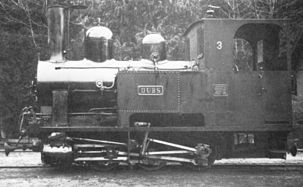WB G 3/3 (Krauss)
| WB G 3/3 | |
|---|---|
|
Dubs as delivered in 1882
|
|
| Numbering: | 3 |
| Manufacturer: | Krauss & Comp. , Munich |
| Year of construction (s): | 1882 |
| Retirement: | 1940 |
| Axis formula : | C. |
| Gauge : | 750 mm |
| Length over coupling: | 5,340 mm |
| Fixed wheelbase: | 1,800 mm |
| Empty mass: | 10.7 t (11.0 t) |
| Service mass: | 14.0 t (14.5 t) |
| Friction mass: | 14.0 t (14.5 t) |
| Top speed: | 25 km / h |
| Starting tractive effort: | 1,650 kg / 120 hp |
| Driving wheel diameter: | 750 mm |
| Number of cylinders: | 2 |
| Cylinder diameter: | 225 mm |
| Piston stroke: | 350 mm |
| Boiler overpressure: | 14 atm. |
| Number of heating pipes: | 71 (77) |
| Heating pipe length: | 2,200 mm |
| Grate area: | 0.44 m 2 (0.53 m 2 ) |
| Evaporation heating surface: | 23.55 m 2 (26.65 m 2 ) |
| Locomotive brake: | External brake |
| Control: | Stephenson |
| Figures in brackets from 1903 onwards | |
The G 3/3 is a steam locomotive series of the Waldenburgerbahn (WB). A total of five locomotives of this type were delivered to the WB. Four machines come from the " Schweizerische Lokomotiv- und Maschinenfabrik " (SLM) in Winterthur (see: WB G 3/3 (Winterthur) ). Only the first delivered locomotive was manufactured by Georg Krauss in the " Lokomotivfabriken Krauss & Comp. " In Munich and delivered to the WB in 1882 for 10,710 German Reichsmarks.
The original spelling of the name Krauss was changed to Krauss, as capital letters were used on the nameplates.
history
The Waldenburgerbahn began operating the timetable on November 1, 1880 with two steam locomotives supplied by SLM. These were "two-coupler tank locomotives" G 2/2, with the WB operating numbers 1 and 2. In the first year of operation, over 73,500 passengers and 248 tons of goods of all kinds were carried. The transport volume increased steadily. The two little machines soon reached their performance limits. On September 29, 1881, Krauss & Comp. ordered a "three-coupler tank locomotive". This could start the timetable service on June 4, 1882. The G 3/3 was given the WB operating number 3. In memory of former Federal Councilor Jakob Dubs (1822–1879), who was very committed to promoting narrow-gauge and regional railways, No. 3 was given the name "Dubs". During its service time, the locomotive underwent various modifications and retrofits, which in 1903 almost led to a completely new building. On January 6, 1915, the "Dubs" was suspended from the timetable service and, after many lead times and reserve services, sold to Reimann, Schiff- und Wasserbau, in Basel, on October 25, 1940.
Technical
The G 3/3 built under the serial number 1049 at Krauss & Comp., In Munich, was now the most powerful of the steam locomotives in service with the WB. With it, trains weighing 30 tons could be pulled uphill (the greatest gradient is 35 ‰). When it was delivered in 1882, the boiler was fitted with a screw valve regulator. There was no steam dome . The locomotive was equipped with an external brake according to Carl Exter . The engine with Stephenson controls , according to Robert Stephenson , was protected by sheet metal casing. The driving force acted on the third axle and was transmitted to the other two axles via a coupling rod. In 1890 the boiler at SLM in Winterthur was fitted with a steam dome. From 1892 the locomotive was converted to a counter-pressure brake . A speedometer and the automatic vacuum brake , based on the Hardy system, were also installed. The connections for the steam heating were also available. In 1903 the locomotive was completely overhauled at SLM in Winterthur. A completely new boiler with a shorter chimney has been built. In 1905, the engine finally had to be replaced. Replacing the sheet metal cladding was probably dispensed with.
literature
- Claude Jeanmaire: Steam Archive No. 4 , Verlag Eisenbahn, Basel, 1968
- Friedrich Gysin: Waldenburgerbahn , Verlag Dietschi AG, Waldenburg, 2000, ISBN 3-905404-14-1
Individual evidence
- ↑ this corresponds to 20,250 Swiss francs

